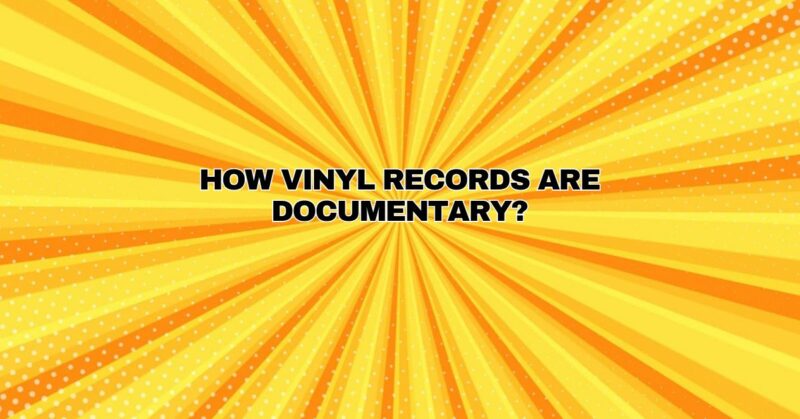Vinyl records are more than just a medium for listening to music; they are living artifacts that have played a pivotal role in documenting the history of music and culture. These iconic black discs have captured the essence of musical genres, social movements, and technological advancements throughout the 20th and 21st centuries. In this comprehensive exploration, we delve into how vinyl records serve as documentary vessels, preserving and reflecting the rich tapestry of human creativity and expression.
1. The Birth of Recorded Music: A Historical Milestone
The story of vinyl records begins with the invention of recorded sound. In the late 19th century, Thomas Edison’s phonograph and Emile Berliner’s gramophone pioneered the technology to capture sound and play it back. These early inventions, using various materials like wax cylinders and shellac discs, laid the foundation for the development of the vinyl record.
2. Vinyl’s Dominance: The Era of 78 RPM Shellac Records
The 78 RPM (revolutions per minute) shellac record dominated the music industry from the late 19th century to the mid-20th century. These brittle, shellac-based discs documented everything from classical performances to vaudeville acts, blues legends, and early jazz bands. As technology improved, records became more durable, and the format allowed musicians to reach a wider audience.
3. The Rise of LPs: A Revolution in Long-Form Listening
In the late 1940s, Columbia Records introduced the long-playing (LP) record, revolutionizing the way music was presented and consumed. Unlike the 78 RPM records, which could hold only a few minutes of music on each side, LPs could accommodate extended compositions and full-length albums. This innovation gave birth to the concept of the “album” as an artistic statement and a cohesive collection of songs.
4. The Power of Cover Art: A Visual Documentary
Vinyl records are not only about the music but also the visual artistry of their cover designs. Album covers serve as a powerful visual documentation of the music, the era, and the culture in which they were created. Iconic album covers, such as The Beatles’ “Sgt. Pepper’s Lonely Hearts Club Band” or Pink Floyd’s “The Dark Side of the Moon,” are celebrated as works of art in their own right and have become cultural touchstones.
5. Vinyl and Cultural Movements: A Reflection of Society
Vinyl records have mirrored and documented cultural movements and societal shifts. From the countercultural revolution of the 1960s, with its folk and rock anthems, to the punk rebellion of the 1970s and the hip-hop explosion of the 1980s and beyond, vinyl records have provided a sonic backdrop to these transformative moments in history.
6. Collectible Records: Preserving Musical Heritage
Vinyl record collecting is a passionate hobby that serves as a form of cultural preservation. Collectors scour record shops, flea markets, and online marketplaces to unearth rare and obscure records. These collectors act as archivists, preserving the musical heritage of bygone eras and ensuring that the sounds of the past are not forgotten.
7. Vinyl’s Resurgence: A Testament to Timelessness
Despite the digital revolution, vinyl records never truly disappeared. In fact, they have experienced a remarkable resurgence in popularity in recent years. Audiophiles and younger generations are drawn to the analog warmth and tactile experience of vinyl. Record stores have sprung up again, and new albums are released in vinyl format alongside digital versions.
8. The Vinyl Revival: A Living History
The vinyl revival not only keeps the format alive but also continues to document music history. Modern artists, from indie bands to chart-toppers, release their music on vinyl, contributing to an ongoing narrative of musical creativity and expression.
9. The Preservation Challenge: Protecting Vinyl’s Legacy
Preserving vinyl records for future generations is a critical challenge. Records are susceptible to damage from factors such as mold, humidity, and physical wear and tear. Archivists, museums, and preservationists work diligently to restore and digitize aging records, ensuring that their historical significance endures.
10. The Timeless Appeal: Vinyl as a Time Capsule
In essence, vinyl records are time capsules, encapsulating the spirit of their era and the creativity of the artists who contributed to them. From the raw, crackling blues of Robert Johnson to the symphonic brilliance of Beethoven, from the rebellious punk anthems of the Sex Pistols to the introspective ballads of Bob Dylan, vinyl records are a testament to the diversity and depth of human musical expression.
In conclusion, vinyl records are more than just a format for playing music; they are living documents that capture the essence of culture, artistry, and history. They serve as a window into the past, a connection to the present, and a bridge to the future. Whether you’re a collector, an audiophile, or a casual listener, vinyl records offer a tangible and immersive experience that allows you to travel through time and immerse yourself in the rich tapestry of musical heritage. Vinyl records continue to be a treasured medium for documenting, preserving, and celebrating the art of sound and the soul of music.


